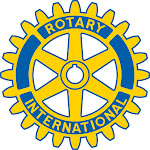The countryside of Coyhaique is the kind that takes your breath away. Actually, not to bragg, but the whole landscape is very simlair to Colorado and Wyoming in many ways. Crystal clear lakes and rivers, steep, rugged mountains, cows-a-grazin´. You know the look.
We visited with two Rotary Clubs during our stay. The first meeting was that of a gentlemen´s club and was unique as it was held in a quincho (large open-spaced building where people can congrate and cook up huge sides of beef over an open fire) on a hillside, overlooking the town of Coyhaique. The members were very reflective and spoke about the importance of May 1st, or ¨Labor Day¨, as we call it.
The following day we had a wonderful time with the women´s club (1st yet!). The qunicho was absolutely spectacular as was the food, company, and entertainment.
Our stop in the nearby pueblo of Puerto Asyen was short but sweet. We were welcomed warmly, as usual. Field trips included a walk in a temperate rainforst (wow) and a very informative tour of a salmon opertation (farm and processing plant). We were all intrigued not to mention impressed. Chilean salmon is the world´s best.
Planes, trains (actaully, no trains), and automobiles took us to the City of Puerto Montt. I think we rolled in a bit tired, but all three Puerto Montt Clubs took wonderful care of us and proudly showed us their small city including a large shopping mall, the coast and finest restaurants, surrounding quaint pueblos and even a German museum (there are more German descendants, and therefore influence, as we head north). We also all experienced our second vocational visits.
Early this morning, we boarded a bus and were dropped in Osorno. This chapter is to be written in a day or so.... Also, more video clips and pics to come. Oh, one last thing to mention before I hit the hay, we are all very thankful to and for our host families! Surely many there are many more wonderful families to come, but thus far, we have been very fortunate. Muchas gracias!
 After our tour of the Salmon Processing Plant, we were invited to a radio station that is run by one of the local Rotarians. The radio station itself has a long history in the area, boasting one of the oldest stations in the community. Sandy and Joyanne were interviewed in the evening and the interview was broadcast to the community the following morning. As the photo of Amy indicates, there´s always time for fun when visiting a radio station! :)
After our tour of the Salmon Processing Plant, we were invited to a radio station that is run by one of the local Rotarians. The radio station itself has a long history in the area, boasting one of the oldest stations in the community. Sandy and Joyanne were interviewed in the evening and the interview was broadcast to the community the following morning. As the photo of Amy indicates, there´s always time for fun when visiting a radio station! :)






 Here in Osorno, Team Chile has been able to try a variety of "mariscos" (shellfish) prepared in distinct ways like the "chupe de locos." This dish is a rich combination made primarily of shellfish baked in a bowl with "queso" (cheese) on top.
Here in Osorno, Team Chile has been able to try a variety of "mariscos" (shellfish) prepared in distinct ways like the "chupe de locos." This dish is a rich combination made primarily of shellfish baked in a bowl with "queso" (cheese) on top.




 Then on Monday, May 4, our team (looking a bit like bananas), had the opportunity to visit Parque Aiken del Sur, a "parque privado."
Then on Monday, May 4, our team (looking a bit like bananas), had the opportunity to visit Parque Aiken del Sur, a "parque privado."













